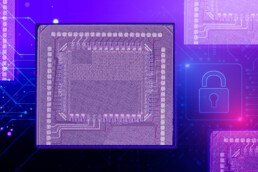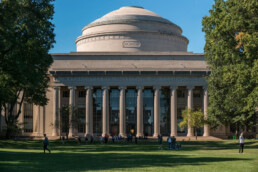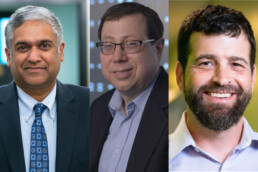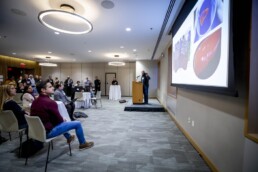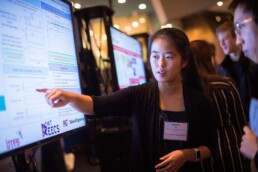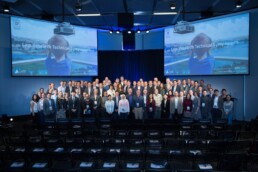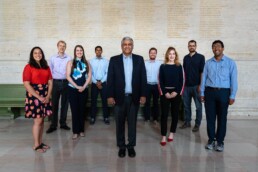This tiny chip can safeguard user data while enabling efficient computing on a smartphone
This tiny chip can safeguard user data while enabling efficient computing on a smartphone
Researchers have developed a security solution for power-hungry AI models that offers protection against two common attacks.
Health-monitoring apps can help people manage chronic diseases or stay on track with fitness goals, using nothing more than a smartphone. However, these apps can be slow and energy-inefficient because the vast machine-learning models that power them must be shuttled between a smartphone and a central memory server.
Engineers often speed things up using hardware that reduces the need to move so much data back and forth. While these machine-learning accelerators can streamline computation, they are susceptible to attackers who can steal secret information.
To reduce this vulnerability, researchers from MIT and the MIT-IBM Watson AI Lab created a machine-learning accelerator that is resistant to the two most common types of attacks. Their chip can keep a user’s health records, financial information, or other sensitive data private while still enabling huge AI models to run efficiently on devices.
The team developed several optimizations that enable strong security while only slightly slowing the device. Moreover, the added security does not impact the accuracy of computations. This machine-learning accelerator could be particularly beneficial for demanding AI applications like augmented and virtual reality or autonomous driving.
While implementing the chip would make a device slightly more expensive and less energy-efficient, that is sometimes a worthwhile price to pay for security, says lead author Maitreyi Ashok, an electrical engineering and computer science (EECS) graduate student at MIT.
“It is important to design with security in mind from the ground up. If you are trying to add even a minimal amount of security after a system has been designed, it is prohibitively expensive. We were able to effectively balance a lot of these tradeoffs during the design phase,” says Ashok.
Her co-authors include Saurav Maji, an EECS graduate student; Xin Zhang and John Cohn of the MIT-IBM Watson AI Lab; and senior author Anantha Chandrakasan, MIT’s chief innovation and strategy officer, dean of the School of Engineering, and the Vannevar Bush Professor of EECS. The research will be presented at the IEEE Custom Integrated Circuits Conference.
Tackling counterfeit seeds with “unclonable” labels
Tackling counterfeit seeds with “unclonable” labels
Fake seeds can cost farmers more than two-thirds of expected crop yields and threaten food security. Trackable silk labels could help.
David L. Chandler | MIT News Office
Average crop yields in Africa are consistently far below those expected, and one significant reason is the prevalence of counterfeit seeds whose germination rates are far lower than those of the genuine ones. The World Bank estimates that as much as half of all seeds sold in some African countries are fake, which could help to account for crop production that is far below potential.
There have been many attempts to prevent this counterfeiting through tracking labels, but none have proved effective; among other issues, such labels have been vulnerable to hacking because of the deterministic nature of their encoding systems. But now, a team of MIT researchers has come up with a kind of tiny, biodegradable tag that can be applied directly to the seeds themselves, and that provides a unique randomly created code that cannot be duplicated.
New program bolsters innovation in next-generation artificial intelligence hardware
New program bolsters innovation in next-generation artificial intelligence hardware
MIT AI Hardware Program launches with five inaugural companies to advance AI technologies for the next decade.
The MIT AI Hardware Program is a new academia and industry collaboration aimed at defining and developing translational technologies in hardware and software for the AI and quantum age. A collaboration between the MIT School of Engineering and MIT Schwarzman College of Computing, involving the Microsystems Technologies Laboratories and programs and units in the college, the cross-disciplinary effort aims to innovate technologies that will deliver enhanced energy efficiency systems for cloud and edge computing.
“A sharp focus on AI hardware manufacturing, research, and design is critical to meet the demands of the world’s evolving devices, architectures, and systems,” says Anantha Chandrakasan, dean of the MIT School of Engineering and Vannevar Bush Professor of Electrical Engineering and Computer Science. “Knowledge-sharing between industry and academia is imperative to the future of high-performance computing.”
Toward a stronger defense of personal data
Engineers build a lower-energy chip that can prevent hackers from extracting hidden information from a smart device.
A heart attack patient, recently discharged from the hospital, is using a smartwatch to help monitor his electrocardiogram signals. The smartwatch may seem secure, but the neural network processing that health information is using private data that could still be stolen by a malicious agent through a side-channel attack.
A side-channel attack seeks to gather secret information by indirectly exploiting a system or its hardware. In one type of side-channel attack, a savvy hacker could monitor fluctuations in the device’s power consumption while the neural network is operating to extract protected information that “leaks” out of the device.
“In the movies, when people want to open locked safes, they listen to the clicks of the lock as they turn it. That reveals that probably turning the lock in this direction will help them proceed further. That is what a side-channel attack is. It is just exploiting unintended information and using it to predict what is going on inside the device,” says Saurav Maji, a graduate student in MIT’s Department of Electrical Engineering and Computer Science (EECS) and lead author of a paper that tackles this issue.
Chip photo courtesy of the researchers
Ericsson and MIT enter into collaboration agreements to research next generation of mobile networks
- Ericsson and MIT to collaborate on two major research projects on the design of state-of-the-art hardware that could one day power next generation 5G and 6G mobile networks
- Lithionics-based device research to enable neuromorphic computing, promising exponentially more energy efficient AI-algorithms than available today
- Advances in hardware could lead to “zero-energy” devices able to harvest energy directly from the received radio signal and use this energy to connect to the mobile network
As we enter a new age for electronics powered by 5G and eventually 6G, MIT and Ericsson (NASDAQ: ERIC) are collaborating on two research projects that seek to help build a new network infrastructure needed to empower the truly revolutionary use cases the next generation of mobile networks will bring.
The new mobile network generations bring ultra-fast speed, low latency, and superb reliability to the end user. However large, feature rich networks are complex structures to manage for network operators. Ericsson is working to research cognitive networks, which rely on artificial intelligence (AI) to enable a secure, highly automized, data-driven network operation. To improve the compute power, speed and energy efficiency of cognitive networks, Ericsson Research and the MIT Materials Research Laboratory are collaborating to research new designs in lithionic chips enabling neuromorphic computing, offering exponentially more energy efficient AI processing. This could enable fully cognitive networks with reduced operation complexity and energy consumption compared to today.
Photo Credit: Ericsson
MIT unveils a new action plan to tackle the climate crisis
The Institute commits to net-zero emissions by 2026, charts course marshaling all of MIT’s capabilities toward decarbonization.
MIT has released an ambitious new plan for action to address the world’s accelerating climate crisis. The plan, titled “Fast Forward: MIT’s Climate Action Plan for the Decade,” includes a broad array of new initiatives and significant expansions of existing programs, to address the needs for new technologies, new policies, and new kinds of outreach to bring the Institute’s expertise to bear on this critical global issue.
As MIT President L. Rafael Reif and other senior leaders have written in a letter to the MIT community announcing the new plan, “Humanity must find affordable, equitable ways to bring every sector of the global economy to net-zero carbon emissions no later than 2050.” And in order to do that, “we must go as far as we can, as fast as we can, with the tools and methods we have now.” But that alone, they stress, will not be enough to meet that essential goal. Significant investments will also be needed to invent and deploy new tools, including technological breakthroughs, policy initiatives, and effective strategies for education and communication about this epochal challenge.
3 Questions: Task Force 2021 and the future of MIT education
Anantha Chandrakasan and Melissa Nobles describe themes that emerged from broad discussions on teaching and learning in the post-Covid world.
MIT’s Task Force 2021 and Beyond has been at work for seven months, charged by President L. Rafael Reif with exploring “how MIT might invent a thriving new future” in a post-Covid world. The effort’s Academic Workstream, which looked specifically at the future of the MIT education, was co-chaired by Anantha Chandrakasan, dean of the School of Engineering and Vannevar Bush Professor of Electrical Engineering and Computer Science, and Melissa Nobles, Kenan Sahin Dean of the School of Humanities, Arts, and Social Sciences and professor of political science.
Chandrakasan and Nobles spoke with MIT News about the recent societal changes that are likeliest to impact teaching and learning at MIT, the themes that arose in their group’s conversations, and the changes that might arise if some of their proposals are adopted.
Three MIT faculty elected 2020 ACM Fellows
Three MIT computer science faculty members have been elected as fellows of the Association for Computing Machinery (ACM).
The new fellows are among 95 ACM members recognized as the top 1 percent for their outstanding accomplishments in computing and information technology and/or outstanding service to ACM and the larger computing community. Fellows are nominated by their peers, with nominations reviewed by a distinguished selection committee.
Anantha Chandrakasan is dean of the School of Engineering and the Vannevar Bush Professor of Electrical Engineering and Computer Science. He leads the MIT Energy-Efficient Circuits and Systems Group, which works on a variety of projects such as ultra-low-power internet-of-things devices, energy-efficient processors, machine learning processors, hardware security for computing devices, and wireless systems. He was recognized as a 2020 ACM fellow for energy-efficient design methodologies and circuits that enable ultra-low-power wireless sensors and computing devices.
MIT-Takeda program launches
Research projects will harness the power of artificial intelligence to positively impact human health.
In February, researchers from MIT and Takeda Pharmaceuticals joined together to celebrate the official launch of the MIT-Takeda Program. The MIT-Takeda Program aims to fuel the development and application of artificial intelligence (AI) capabilities to benefit human health and drug development. Centered within the Abdul Latif Jameel Clinic for Machine Learning in Health (Jameel Clinic), the program brings together the MIT School of Engineering and Takeda Pharmaceuticals, to combine knowledge and address challenges of mutual interest.
Following a competitive proposal process, nine inaugural research projects were selected. The program’s flagship research projects include principal investigators from departments and labs spanning the School of Engineering and the Institute. Research includes diagnosis of diseases, prediction of treatment response, development of novel biomarkers, process control and improvement, drug discovery, and clinical trial optimization.
“We were truly impressed by the creativity and breadth of the proposals we received,” says Anantha P. Chandrakasan, dean of the School of Engineering, Vannevar Bush Professor of Electrical Engineering and Computer Science, and co-chair of the MIT-Takeda Program Steering Committee.
Cryptographic “tag of everything” could protect the supply chain
Tiny, battery-free ID chip can authenticate nearly any product to help combat losses to counterfeiting.
To combat supply chain counterfeiting, which can cost companies billions of dollars annually, MIT researchers have invented a cryptographic ID tag that’s small enough to fit on virtually any product and verify its authenticity.
A 2018 report from the Organization for Economic Co-operation and Development estimates about $2 trillion worth of counterfeit goods will be sold worldwide in 2020. That’s bad news for consumers and companies that order parts from different sources worldwide to build products.
Counterfeiters tend to use complex routes that include many checkpoints, making it challenging to verifying their origins and authenticity. Consequently, companies can end up with imitation parts. Wireless ID tags are becoming increasingly popular for authenticating assets as they change hands at each checkpoint. But these tags come with various size, cost, energy, and security tradeoffs that limit their potential.
At halfway point, SuperUROP scholars share their research results
In a lively poster session, more than 100 undergraduates discuss their yearlong research projects on everything from machine learning to political geography.
MIT undergraduates are rolling up their sleeves to address major problems in the world, conducting research on topics ranging from nursing care to money laundering to the spread of misinformation about climate change — work highlighted at the most recent SuperUROP Showcase.
The event, which took place on the Charles M. Vest Student Street in the Stata Center in December 2019, marked the halfway point in the Advanced Undergraduate Research Opportunities Program (better known as “SuperUROP”). The yearlong program gives MIT students firsthand experience in conducting research with close faculty mentorship. Many participants receive scholar titles recognizing the program’s industry sponsors, individual donors, and other contributors.
This year, 102 students participated in SuperUROP, with many of their projects focused on applying computer science technologies, such as machine learning, to challenges in fields ranging from robotics to health care. Almost all presented posters of their work at the December showcase, explaining research to fellow students, faculty members, alumni, sponsors, and other guests.
MIT School of Engineering and Takeda join to advance research in artificial intelligence and health
A key part of J-Clinic, the MIT-Takeda Program will create educational opportunities and support cutting-edge research to positively impact human health.
MIT’s School of Engineering and Takeda Pharmaceuticals Company Limited today announced the MIT-Takeda Program to fuel the development and application of artificial intelligence (AI) capabilities to benefit human health and drug development. Centered within the Abdul Latif Jameel Clinic for Machine Learning in Health (J-Clinic), the new program will leverage the combined expertise of both organizations, and is supported by Takeda’s three-year investment (with the potential for a two-year extension).
This new collaboration will provide MIT with extraordinary access to pharmaceutical infrastructure and expertise, and will help to focus work on challenges with lasting, practical impact. A new educational program offered through J-Clinic will provide Takeda with the ability to learn from and engage with some of MIT's sharpest and most curious minds, and offer insight into the advances that will help shape the health care industry of tomorrow.
“We are thrilled to create this collaboration with Takeda,” says Anantha Chandrakasan, dean of MIT’s School of Engineering. “The MIT-Takeda Program will build a community dedicated to the next generation of AI and system-level breakthroughs that aim to advance healthcare around the globe.”
Smart systems for semiconductor manufacturing
Lam Research Tech Symposium, co-hosted by MIT.nano and Microsystems Technology Lab, explores challenges, opportunities for the future of the industry.
Integrating smart systems into manufacturing offers the potential to transform many industries. Lam Research, a founding member of the MIT.nano Consortium and a longtime member of the Microsystems Technology Lab (MTL) Microsystems Industrial Group, explored the challenges and opportunities smart systems bring to the semiconductor industry at its annual technical symposium, held at MIT in October.
Co-hosted by MIT.nano and the MTL, the two-day event brought together Lam’s global technical staff, academic collaborators, and industry leaders with MIT faculty, students, and researchers to focus on software and hardware needed for smart manufacturing and process controls.
Tim Archer, president and CEO of Lam Research, kicked off the first day, noting that “the semiconductor industry is more impactful to people's lives than ever before."
Students spearhead group to enhance the graduate experience
School of Engineering advisory group proposes a new leadership curriculum and stronger student-advisor relationships.
What do graduate students in engineering want?
This was the question before a new advisory group launched by the MIT School of Engineering in late 2017 — the school’s first comprised entirely of graduate students. This fall the group is rolling out its inaugural initiatives: a graduate-level leadership minor or certificate and a set of recommendations intended to improve advisor-advisee relations.
GradSAGE (short for Graduate Student Advisory Group for Engineering) was established by Anantha Chandrakasan just months after he became dean of the MIT School of Engineering.
“I thought it would be great to get student engagement as we shaped new initiatives, and to learn their perspectives on important issues and challenges they face,” says Chandrakasan. “In a sense, we are listening to our customers.”
The dean already counted department heads and other school stakeholders among his advisors. But Chandrakasan, the Vannevar Bush Professor of Electrical Engineering and Computer Science, felt he was missing the voice of students.
MIT engineers build advanced microprocessor out of carbon nanotubes
The microprocessor, described today in the journal Nature, can be built using traditional silicon-chip fabrication processes, representing a major step toward making carbon nanotube microprocessors more practical.
Silicon transistors — critical microprocessor components that switch between 1 and 0 bits to carry out computations — have carried the computer industry for decades. As predicted by Moore’s Law, industry has been able to shrink down and cram more transistors onto chips every couple of years to help carry out increasingly complex computations. But experts now foresee a time when silicon transistors will stop shrinking, and become increasingly inefficient.
